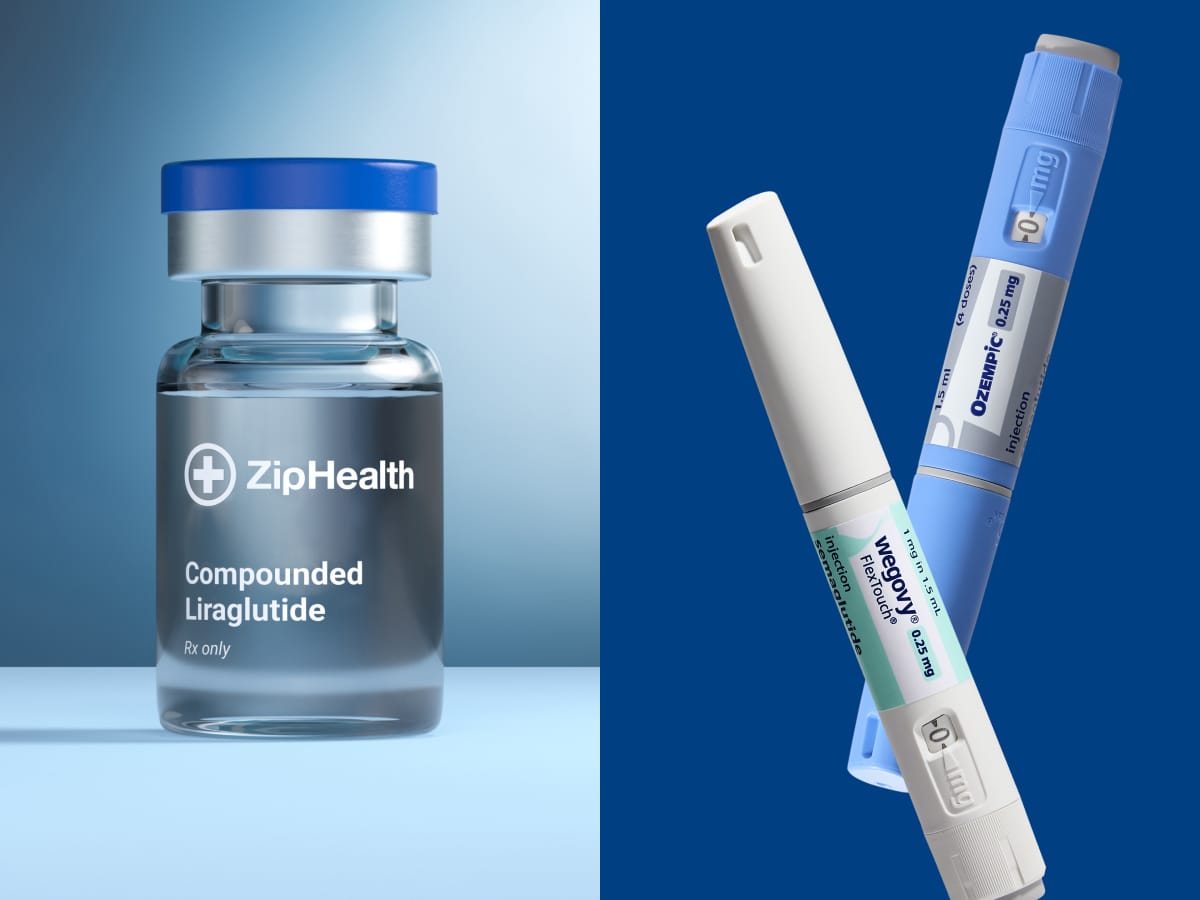Liraglutide vs Semaglutide: The Key Differences
In this article, we explore how liraglutide compares to semaglutide and how they differ in terms of dosing, side effects, cost, duration and overall weight loss treatment effectiveness.

GLP-1 receptor agonists like liraglutide and semaglutide are popular weight loss tools for people with diabetes, obesity or excess body weight. Not only do these weight loss injections support sustainable weight reduction, but they also lead to health benefits, including improved blood sugar control and reduced risk of cardiovascular disease.
In this article, we’ll explore how these two weight loss medications work, compare their dosing and side effects, and discuss what to expect in terms of cost, duration, and overall effectiveness from each option. Remember that liraglutide and semaglutide are prescription-only medications and should only be used under the supervision of a qualified healthcare provider.
An overview of GLP-1 receptor agonists and how they work
GLP-1 receptor agonists like liraglutide and semaglutide are two types of prescription weight loss medication originally developed to treat type 2 diabetes. Today, they’re widely prescribed to support weight reduction in adults with obesity or who struggle with obesity or overweight and related health conditions.
These medications mimic the hormone GLP-1, which helps regulate appetite, increase feelings of fullness, and control blood sugar levels. In this way, GLP-1 receptor agonists make it easier to eat less, which can result in substantial, sustained weight loss over time. Like all medications, they may cause side effects, but when used correctly under clinical supervision, they have been shown to be safe and effective tools for managing body weight.
How liraglutide and semaglutide are used in weight management
Though originally developed for patients with type 2 diabetes, GLP-1 receptor agonists are now FDA-approved for weight management in adults with a body mass index (BMI) of 30 or higher, or 27 or higher with weight related health conditions. These medications are particularly effective when combined with physical activity and a calorie-controlled diet.
In addition to supporting body weight reduction, GLP-1 receptor agonists have been shown to lower blood pressure, improve blood sugar control, and reduce the risk of weight-related health issues like cardiovascular disease. They represent a powerful tool in long-term weight loss strategies for patients who haven’t found success with diet and exercise alone.
Dosage schedules of liraglutide and semaglutide
In clinical practice, liraglutide and semaglutide are both self-injected GLP-1 medications, but liraglutide is administered as a once-daily injection, while semaglutide is taken once a week.
With both medications, your healthcare provider will start you on a low dose that increases gradually to help the body adjust and reduce the risk of adverse effects such as nausea. After taking medication for a while, a maintenance dose is prescribed to support ongoing weight loss and help reach and maintain a healthy body weight. It takes about 5 weeks to reach a maintenance dose with liraglutide, but it can take 17 weeks to reach a maintenance dose with semaglutide.
How useful are GLP-1 receptor agonists for weight loss?
GLP-1 receptor agonists are among the most effective weight loss medications available. As well as supporting weight management, they reduce the risk of cardiovascular disease and can prevent the onset of type 2 diabetes. Clinical trials highlight the powerful impact of these medications, confirming that GLP-1 receptor agonists can be an excellent tool for weight loss. [1, 2]
Liraglutide vs. semaglutide: findings from clinical trials
Clinical trials have shown that in just over a year, semaglutide led to an average loss of 14.9% of overall body weight, while liraglutide led to an average loss of 8%. [1, 2] The most successful body weight reductions are seen when the medication is used as part of a wider treatment plan that includes a healthy lifestyle, physical exercise and a nutritious, calorie-conscious diet. [3]
How long can you take liraglutide or semaglutide for weight loss?
Both liraglutide and semaglutide are designed for long-term use over several months or even years. How long a patient uses the treatment depends on their response, goals, and overall health profile. Some individuals see results more quickly than others because of differences in their physical activity, diet, and metabolism. Using the medication correctly and consistently is key to achieving and maintaining a healthy body weight.
Can you switch from semaglutide to liraglutide?
Sometimes your healthcare provider may recommend a switch between GLP-1 medications. This may be due to side effects, cost, or a preference for a daily vs. weekly dosing schedule. Others may switch if one medication isn't providing the desired weight loss results.
Side effects of liraglutide vs semaglutide
Sometimes liraglutide and semaglutide can cause side effects, especially when treatment begins or during dose escalation. Very common side effects include [4, 5]:
Liraglutide:
- Nausea
- Diarrhoea
- Constipation
- Headache
- Fatigue
Semaglutide:
- Nausea
- Vomiting
- Constipation
- Abdominal pain
- Headache
- Fatigue
Serious side effects of both medications may include severe abdominal pain which could be a sign of pancreatitis, gallbladder problems, or very low blood sugar (especially in people also taking diabetes medications). In rare cases, either medication can cause a severe allergic reaction, including swelling of the lips, tongue or throat, a rash, or difficulty breathing. If you experience any of these, it is important that you call 911 or go to the emergency department immediately.
Managing potential side effects
To minimize the risk of side effects, doses are started low and increased gradually to allow your body time to get used to the medication. Very common side effects like nausea, constipation, diarrhoea, and headaches often lessen as your body adjusts. ZipHealth's Compounded* Liraglutide with B12 has been formulated with vitamin B12, which helps to reduce the risk of potential side effects.
Many people choose to inject their medication in the evening, as side effects tend to be strongest in the hours after taking the medication. This way, they can sleep through the worst of any adverse effects.
How much do liraglutide and semaglutide cost?
Liraglutide is generally cheaper than semaglutide. Semaglutide can cost thousands of dollars per month, while at ZipHealth we offer a subscription to Compounded* Liraglutide with B12 at just $179 a month, with $50 off your first month. This is a fraction of the cost of the leading brand-name liraglutide injection, Saxenda.
When deciding which weight loss medication to use, bear in mind that both liraglutide and semaglutide are long-term treatments prescribed over a course of many months or possibly even years, so it's important to feel confident in the financial commitment you're making over this time period. Disruptions to treatment will slow down your weight loss progress and may have adverse effects.
How to get the most out of weight loss treatment with GLP-1 agonists
For the best results with GLP-1 agonists, treatment should always be paired with a healthy lifestyle. That includes a calorie-controlled diet, regular physical activity, and ongoing support from your provider. These lifestyle changes help improve overall health, and reduce your body mass index more effectively than medication alone. [3]
GLP-1 receptor agonists like liraglutide and semaglutide have transformed the health profiles of people with diabetes, obesity, or a high body mass index with weight-related health issues. They offer safe and effective weight reduction, especially when combined with healthy lifestyle habits. If you're considering a GLP-1 for weight loss, understanding your treatment options, costs, and potential side effects can help you make an informed, confident decision.
If you want to learn more about how GLP-1 weight loss injections could help you with your health journey, book a consultation to find out which options may be best suited to you on our website.
*Compounded drugs are permitted to be prescribed under federal law but are not FDA-approved and do not undergo FDA review for safety, effectiveness, or quality.
References
- Wilding JPH, Batterham RL, Calanna S, Davies M, Van Gaal LF, Lingvay I, McGowan BM, Rosenstock J, Tran MTD, Wadden TA, Wharton S, Yokote K, Zeuthen N, Kushner RF; STEP 1 Study Group. Once-Weekly Semaglutide in Adults with Overweight or Obesity. N Engl J Med. 2021 Mar 18;384(11):989-1002. doi: 10.1056/NEJMoa2032183.
- Pi-Sunyer X, Astrup A, Fujioka K, Greenway F, Halpern A, Krempf M, Lau DC, le Roux CW, Violante Ortiz R, Jensen CB, Wilding JP; SCALE Obesity and Prediabetes NN8022-1839 Study Group. A Randomized, Controlled Trial of 3.0 mg of Liraglutide in Weight Management. N Engl J Med. 2015 Jul 2;373(1):11-22. doi: 10.1056/NEJMoa1411892.
- Lundgren JR, Janus C, Jensen SBK, Juhl CR, Olsen LM, Christensen RM, et al. Healthy Weight Loss Maintenance with Exercise, Liraglutide, or Both Combined. New England Journal of Medicine. 2021 May 6;384(18):1719–30.
- Rubino D, Abrahamsson N, Davies M, Hesse D, Greenway FL, Jensen C, et al. Effect of Continued Weekly Subcutaneous Semaglutide vs Placebo on Weight Loss Maintenance in Adults With Overweight or Obesity: The STEP 4 Randomized Clinical Trial. JAMA [Internet]. 2021 Apr 13;325(14):1414–25. Available from: https://jamanetwork.com/journals/jama/fullarticle/2777886
- Secher A, Jelsing J, Baquero AF, Hecksher-Sørensen J, Cowley MA, Dalbøge LS, et al. The arcuate nucleus mediates GLP-1 receptor agonist liraglutide-dependent weight loss. The Journal of Clinical Investigation [Internet]. 2014 Oct 1;124(10):4473–88. Available from: https://www.ncbi.nlm.nih.gov/pmc/articles/PMC4215190/
